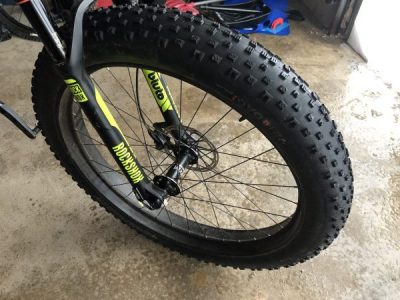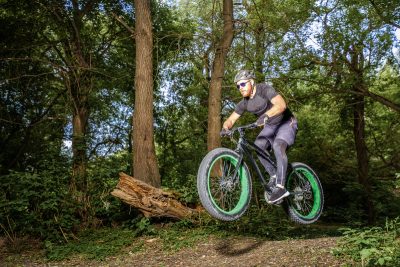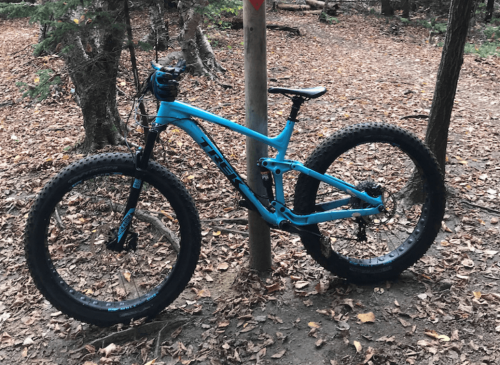Fat bikes bring a lot to the table, but one thing that is tough to find on the market is a great suspension. There are a lot of limitations with the build of a fat bike to make that work. Some people are just fine with it, as there are other ways to have a very comfortable ride. For others, they are still on the hunt for the best fat bike suspension.
What is the best type of fat bike suspension? Is a rigid fat bike the perfect set up for a person to have? We dive into what solutions are out there, and what makes sense for individuals.
Why Full Suspension is Tough to Find With Fat Bikes
When a person first starts to look for any type of suspension on a fat bike, they might be surprised that there is so little available. There’s a reason for that, and it mostly comes down to the fact that fat bikes are pretty comfortable to ride even without suspension.
The combination of a low PSI and softer surfaces do not make it particularly tough on the body to ride at times. People enjoy the rigid setup, even if it is much less rigid and other options out there.
People new to fat bikes will notice right away that big tires absorb a lot of the huge bumps, and even the smaller ones as well. That means that adding suspension isn’t going to make a noticeable difference for people. Instead, it is just going to make the bike a little more expensive, without really proving much in the way of results.
The lack of suspension on fat bikes is mostly a cost-cutting move to make them more affordable and accessible to the masses. Some people are initially puzzled by this, but it makes sense considering the qualities it has.
Investing in a Suspension Fork

One of the best ways to get a good amount of suspension on a fat bike is to invest in a suspension fork. There are, of course, many advantages to using a suspension fork with any type of bike. For a fat bike, in particular, it helps to soften the ride overall, and improves steering precision and cornering.
It also helps to make a fat bike a quality option to ride during the entire year. There are certain times throughout the year where the suspension is a little more needed.
Think about the summer, when the ground might be a little harder to ride on it depending on the trail. Another scenario is if there is more ice than snow in the winter. Solid ice can be very hard, and a fork will smooth it out.
Investing in Full Suspension
Front suspension fat bikes have its fans (Me), but others want to go all out and get full-suspension on their fat bike. It is not as common as one would think, but there are ways to get this setup. Without question, it makes for a very comfortable experience, and most riders feel like they are in better overall control.
Safety is another selling point of fall suspension. Some riders feel very uneasy about bouncing around and not always having control on different surfaces with a rigid fat bike.
By investing in full suspension, the bike does not bounce around nearly as much. It still has the capability of handling all different surfaces, but the responsiveness is a step in the right direction.
Just about everyone will focus on suspension helping with the comfort of riding a bike. From a fat bike perspective, it also helps provide better grip and control with the bike on different rings.
On average, full-suspension adds around 5 pounds or more to the bike. This is pretty significant for any type of bike, and it might slow down the faster riders at first. It is not as noticeable as some might think, but it could cause a person to have to put in a little bit more effort to see the same results.
Is Suspension Necessary for All Riders?
Generally speaking, the softer the terrain is for a fat bike rider, the less they actually need any type of suspension. Those who ride almost exclusively on snow and sand will likely go without any kind of suspension, and be just fine.
They might be missing out on some minor improvements, but nothing that significantly changes the ride. Considering the cost, the added weight, and more, it is a calculated decision for some.
Suspension becomes a little more important when riding on rough terrain with plenty of rocks and roots in the way. Taking those bumps takes a toll on any rider, so full or even front suspension would help in that regard.
Of course, having suspension can turn into a negative for some riders as well. A lot of people complain about the ride feeling like the bike is a bit choppy. While suspension of any kind should be helping, it is hurting the rider in this regard if they do not feel like they have solid control.
It is also more weight added to an already fairly heavy bike. Even adding front suspension is going to add a couple of pounds, but full suspension will make it even heavier. The trade-off is just way too much for some to see minimal impact.
Other Ways to Handle Rough Terrain Without a Suspension

Having some type of suspension on a fat bike helps, but there are other ways to handle shock and general discomfort when riding on challenging terrains. These alternatives might be a better way to go for some.
Gloves
Adding a pair of gloves helps to absorb any type of bumps without much of an investment. Go with gloves that have a good amount of cushioning, but also solid grip. Most will be counting on these gloves last a very long time during a long ride.
Gloves come in all different types to handle different parts of the year as well. The hands are very vulnerable during long rides, so wearing them 12 months out of the year is necessary.
Additional bike grip
Quality bike grip can help absorb some shock and make for a more comfortable experience when riding as well. The default grip on those bikes helps a little, but for a relatively low price, adjustments can take things to another level.
Combining both quality grip and gloves will provide some great overall support. By killing some of the shock that goes through the body right at the hands, it yields some great value.
Switching out the stem of the fat bike
This might be a costly move for some, but switching out and upgrading the stem on a fat bike is another solution to handle in shock. If a fat bike does not come with a solid stem in the first place, this upgrade isn’t quite the same as adding suspension, although the result is pretty similar.
People like to add and replace stems a little more frequently with road bikes. This is where people are always trying to find the best fit for them, either from a height perspective, or from a material standpoint.
There is no question that a stem made of carbon is going to do a much better job handling shock than some of the other options out there. If a fat bike does not come default with a carbon stem, is worth looking into.
Should You or Shouldn’t You get a Front Suspension Fat Bike?
After weighing all the pros and cons of having suspension on a fat bike, a person might still be confused. If that is the case, try to do whatever possible to test ride a few fat bikes before making a purchase.
Surprisingly, very few people take the time to test ride before making a considerable purchase. Sometimes it is hard to find a local bike shop that carries numerous options, but it is worth putting in the effort before possibly spending thousands of dollars. Reading reviews online help, but there’s something about actually feeling a difference that might sway person in one direction or the other.
Remember that adding suspension to a fat bike is possible after purchasing, but it usually ends up costing more than getting it initially.

